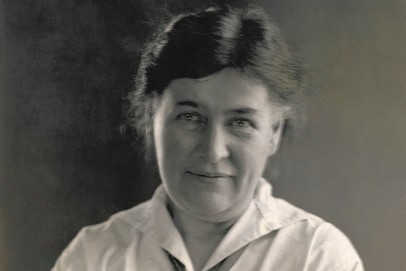|
with Angela Harris Warming up with Willa Willa Cather Willa Cather After our three-minute free-write in our journals (we start every class this way; it gets us warmed up and underscores a topic or theme found in the novel we are reading/discussing at the moment), we heard about the life and experiences of our current author, Willa Cather, and the model for possibly her most famous heroine, Ántonia Shimerda. Willa Cather did not want her novels to be read as veiled autobiography, but My Ántonia parallels many of her life’s experiences. Many literary scholars argue that Jim Burden is Willa Cather. For example, Jim and Cather both left Virginia as young children and lived on the Nebraska prairie. Cather’s family then moved to Red Cloud a year later; Jim’s family moves to the fictional town, Black Hawk. Cather gave her high school graduation speech, as does Jim; then they both studied at the University of Nebraska in Lincoln. After graduation, they leave Nebraska for the east: Jim to study law at Harvard; Cather to work as editor at Home Monthly in Pittsburgh. I love this quote from Cather: Art must spring out of the very stuff that life is made of. The German housewife who sets before her family on Thanksgiving day a perfectly roasted goose, is an artist. The farmer who goes out in the morning to harness his team, and pauses to admire the sunrise—he is an artist. What do you think this means? How can a housewife be an artist if she hasn't painted anything? How is a farmer an artist if he's simply admiring the sunset? Please think about this and we'll talk about its meaning next week. Cather was an author who was captivated by the simplicity of prairie life and expressed her thoughts in words that truly approach poetry. Cather quotes are absolutely life affirming. H.L. Mencken said, “No romantic novel ever written in America, by man or woman, is one half so beautiful as MY ANTONIA.” As you read, notice places in the novel that are written in such a way as to conjure up a particular image. Re-read these parts to understand them better. Roll the images about in your mind. Taking the time to enjoy the novel in this way is not only far more engaging but (hint) will help you with another essay coming up in a few weeks! Paraphrasing ExerciseIn preparation for our expository essay writing assignment this week, we took some time to understand what makes a good paraphrase. Each student had selected a piece of research that they had identified last week as being valuable in providing points and particulars for their five-paragraph essay on the topic of immigration. We read our articles with a view to choosing a point that we could put into our own words. We wanted to look for a point, not just a comment. A comment not worth paraphrasing will not have a specific fact or unique idea to contribute. Look for facts, data, statistics, or conclusions built on those things. Expert opinion also qualifies. (Be sure to include their qualifications: see Citing Sources below). Paraphrasing means taking ideas and putting them into your own words and sentence structure. The length and style of the sentence should be maintained, but the language and structure should be different. We then chose the quote or piece of information that we wanted to practice paraphrasing and wrote it out exactly as it appeared. Then, on a separate sheet, we wrote out our own version WITHOUT looking at the original. We shared the original and then our paraphrase. These usually need more than one attempt. After the first attempt, you can go ahead and look at the original quote and try a second draft. I actually think all the students did pretty well on their first draft--we didn't have time for a second attempt, but I think they get the general idea! I wanted to practice summarizing as well, but that will have to wait for another day and time. Important: Citing SourcesAt the end of class we went over a guide to expository essay writing that I put together for the students. Please read the sample essay one time all the way through just to get the meaning. The second time compare the essay to the guide to see how this particular student followed the steps to complete the essay. Do not attempt to write an expository essay without reading one first. Would you attempt to write out instructions on how to ride a bike without knowing how to ride one yourself? Writing an expository essay without ever having read one is just as silly!
Once we become more comfortable with essay writing (e.g., next year) we can relax the formulaic approach. For now, follow the steps and you'll have success! You will need this information to cite sources correctly for this essay: Researchers place brief parenthetical descriptions to acknowledge which parts of their paper reference particular sources. Generally, you want to provide the last name of the author and page number if it’s from a book. If it's from the Internet, you will just put the author's name in parenthesis after the quote or bit that you are paraphrasing or summarizing. PLEASE UNDERSTAND, EVEN IF YOU ARE NOT USING A DIRECT QUOTE YOU MUST GIVE CREDIT. If such information is already given in the body of your sentence, then you don't need a parenthetical citation. Ideally, when citing on-line sources, try to reference the source within your sentence, with either the author or the title to avoid writing a parenthetical citation. Otherwise, place the parenthetical citation where there is a pause in the sentence – normally before the end of a sentence or a comma. If there is no author, use the title that begins the citation, either the article or website title. Be sure it also takes the same formatting as non on-line sources, i.e. articles are in quotes and website titles are italicized. Next session we will learn how to include a "Works Cited" at the end of your paper (the bibliography). Example of information taken from the Internet and you know the author's name: The economy will rebound with the new monetary policies (Smith). Example when you do not know the author's name, but you know the title of the article OR name of web-site: Elephants are thought to be one of the smartest mammals (“Smart Elephants”). This came from an article--use quotes so I know it was an article. Most importantly, if this is not clear, please ask. Citing sources is required for this paper--either within the sentence itself (preferred for on-line sources) or in-line parenthetically as described above. Good luck and see you next week! Comments are closed.
|
Categories
All
Archives
May 2016
|

 RSS Feed
RSS Feed